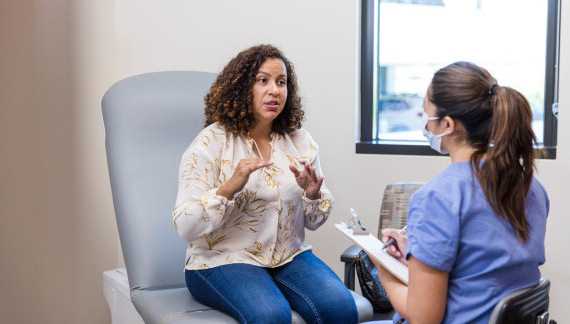Navigation Toolkit: Tips From a Peritoneal Mesothelioma Survivor
Treatment & DoctorsWritten by Tamron Little | Edited By Amy Edel

I received the life-changing diagnosis of peritoneal mesothelioma 17 years ago this month. Overcoming this illness has given me a unique perspective on the challenges of navigating the healthcare system.
At the tender age of 21, I found myself dealing with a disease very few people my age face. I became a trailblazer, not just for my journey but for others who would come after me. I experienced first hand that navigating the difficulties of the healthcare system can be overwhelming, especially for those facing rare or uncommon conditions.
My journey has inspired me to develop a navigation toolkit to empower patients to advocate for their own health. I believe that sharing my experiences and insights can help others facing similar mesothelioma challenges find their way through the maze of medical care with confidence and resilience.
- Communication with your healthcare team
- A plan of action within your plan of care
- A second opinion
- Detailed questions
- Commitment to advocating for yourself
- Follow ups
- Resources to reach out to for help
I had a reminder of how important this toolkit is 2 years ago when I went to the emergency room seeking help with some dull pain I was having on my left side near my rib cage. Sharing this personal story of putting each tool in the healthcare navigation toolkit will hopefully help you in your journey.
1. Communicating With My Healthcare Team
After experiencing pain, a CT scan was done at the ER. They found a small nodule on my left lower lobe. This accidental finding surprised me, even though the ER doctor didn’t seem phased.
He just said it was “normal.” But as a peritoneal mesothelioma survivor, I began to worry. While in the emergency room, I immediately emailed my oncologist and made an appointment for the following week.
It’s imperative to have an effective way of communicating with your healthcare team, especially if you were seen in the ER. This way, they can be in the loop and notified of any changes.
2. Have a Plan of Action Within Your Plan of Care
At my appointment, I was reassured that my oncologist didn’t think it was cancer. We both agreed to watch, wait and do a repeat scan.
Knowing your next steps isn’t only reassuring. It keeps you in the know and creates a sense of control. Although the watch-and-wait period isn’t one of my favorites, it’s a part of the process in this survivorship journey.
3. Get a Second Opinion
When the time came for me to have a repeat scan, not only did it show the one nodule they had seen before, but it also showed another one. Can you even imagine what I was feeling?
I was terrified to say the least. But I got the same reaction: It’s normal for people to have nodules, especially after having COVID-19.
I didn’t take the results lightly, so I got a second opinion. Getting a second or third set of eyes to look at your results is okay.
Once again, I was reassured that there wasn’t anything to be concerned about.
4. Ask Detailed Questions
Earlier this week, I was sitting up in bed reading, and suddenly, I had an electric shock sensation through the left side of my body. I then lay down and felt an electric shock sensation again.
The next day, my left arm felt like it had fallen asleep all day. I contacted my doctor immediately and she sent me to the emergency room.
They took preventive measures and did blood work, an EKG and CT scans. The blood work was fine, and the doctor told me my CT scan was great.
I couldn’t see the results yet in my chart, so I asked him detailed questions. Don’t accept generic statements. Ask detailed questions.
He mentioned that the nodule on my right lobe is stable. He added, “So everything looks great!”
“My right lobe?” I asked. “What do you mean? I have three nodules!”
And he said, “Well, yes, I know it said the right, but let me triple-check.”
I mentioned I thought it was the left, not the right. So, he went over to the computer to check, and boom, I have a new nodule on my right lung.
5. Advocate for Yourself
After confirming I have a new nodule, the ER doctor turned to me and said, “You’re fine. It would be a one-in-a-million chance this could be cancer.”
I looked at him and said, “You know I had peritoneal mesothelioma, right? So, I’m not taking this lightly, although you said it’s ‘normal.’”
He admitted he’s not a specialist, and I said “I know.”
What if I didn’t ask those questions? What if I had taken him at his word of saying everything looked good? I wouldn’t have known it was another nodule.
Don’t be afraid to ask those hard questions. Don’t let them rush you out of the exam room without you being knowledgeable about your diagnosis, test results and next steps.
6. Follow Up With Your Health Care Team
I followed up with my oncologist and asked him for the next steps. Before I could even send my primary care doctor a message, she checked on me. This made my heart smile.
7. Reach Out for Help
I’m truly blessed to know my Patient Advocate friends at The Mesothelioma Center. I reached out to Karen for help, and she’s doing just that. Finding the support you need in your time of need shouldn’t feel embarrassing.
Although lung nodules are said to be common, knowing your medical history, it’s best to get it checked out further. You and your family will be able to sleep better at night.
Navigating the healthcare system as a peritoneal mesothelioma survivor can still be a bumpy and sometimes dimmed path. Being equipped with your navigation toolkit will hopefully make the journey easier.
Meanwhile, I’m standing on my faith and keeping hope alive. I know I’m still cancer-free!






